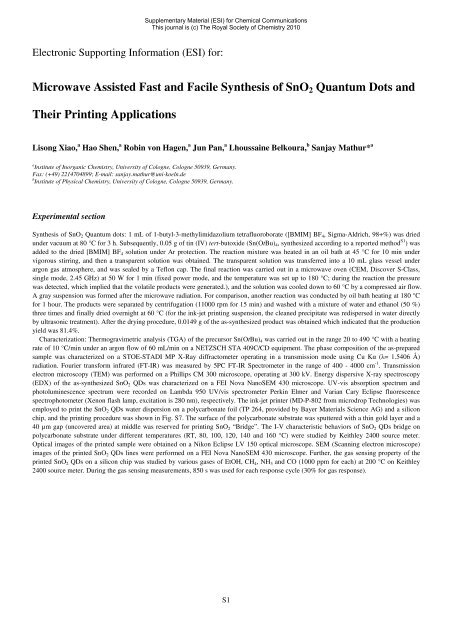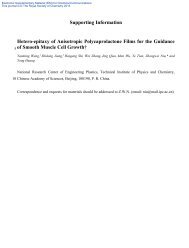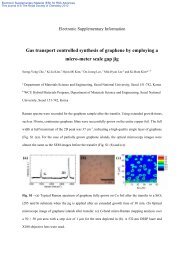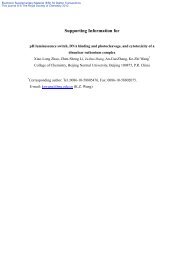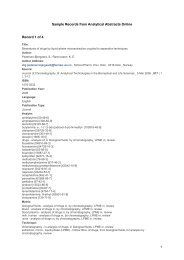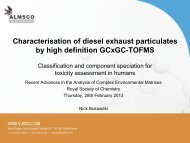Microwave Assisted Fast and Facile Synthesis of SnO2 Quantum ...
Microwave Assisted Fast and Facile Synthesis of SnO2 Quantum ...
Microwave Assisted Fast and Facile Synthesis of SnO2 Quantum ...
Create successful ePaper yourself
Turn your PDF publications into a flip-book with our unique Google optimized e-Paper software.
Electronic Supporting Information (ESI) for:<br />
<strong>Microwave</strong> <strong>Assisted</strong> <strong>Fast</strong> <strong>and</strong> <strong>Facile</strong> <strong>Synthesis</strong> <strong>of</strong> <strong>SnO2</strong> <strong>Quantum</strong> Dots <strong>and</strong><br />
Their Printing Applications<br />
Lisong Xiao, a Hao Shen, a Robin von Hagen, a Jun Pan, a Lhoussaine Belkoura, b Sanjay Mathur* a<br />
a Institute <strong>of</strong> Inorganic Chemistry, University <strong>of</strong> Cologne, Cologne 50939, Germany.<br />
Fax: (+49) 2214704899; E-mail: sanjay.mathur@uni-koeln.de<br />
b Institute <strong>of</strong> Physical Chemistry, University <strong>of</strong> Cologne, Cologne 50939, Germany.<br />
Experimental section<br />
Supplementary Material (ESI) for Chemical Communications<br />
This journal is (c) The Royal Society <strong>of</strong> Chemistry 2010<br />
<strong>Synthesis</strong> <strong>of</strong> SnO 2 <strong>Quantum</strong> dots: 1 mL <strong>of</strong> 1-butyl-3-methylimidazolium tetrafluoroborate ([BMIM] BF 4, Sigma-Aldrich, 98+%) was dried<br />
under vacuum at 80 °C for 3 h. Subsequently, 0.05 g <strong>of</strong> tin (IV) tert-butoxide (Sn(OtBu) 4, synthesized according to a reported method S1 ) was<br />
added to the dried [BMIM] BF 4 solution under Ar protection. The reaction mixture was heated in an oil bath at 45 °C for 10 min under<br />
vigorous stirring, <strong>and</strong> then a transparent solution was obtained. The transparent solution was transferred into a 10 mL glass vessel under<br />
argon gas atmosphere, <strong>and</strong> was sealed by a Teflon cap. The final reaction was carried out in a microwave oven (CEM, Discover S-Class,<br />
single mode, 2.45 GHz) at 50 W for 1 min (fixed power mode, <strong>and</strong> the temperature was set up to 180 °C; during the reaction the pressure<br />
was detected, which implied that the volatile products were generated.), <strong>and</strong> the solution was cooled down to 60 °C by a compressed air flow.<br />
A gray suspension was formed after the microwave radiation. For comparison, another reaction was conducted by oil bath heating at 180 °C<br />
for 1 hour. The products were separated by centrifugation (11000 rpm for 15 min) <strong>and</strong> washed with a mixture <strong>of</strong> water <strong>and</strong> ethanol (50 %)<br />
three times <strong>and</strong> finally dried overnight at 60 °C (for the ink-jet printing suspension, the cleaned precipitate was redispersed in water directly<br />
by ultrasonic treatment). After the drying procedure, 0.0149 g <strong>of</strong> the as-synthesized product was obtained which indicated that the production<br />
yield was 81.4%.<br />
Characterization: Thermogravimetric analysis (TGA) <strong>of</strong> the precursor Sn(OtBu) 4 was carried out in the range 20 to 490 °C with a heating<br />
rate <strong>of</strong> 10 °C/min under an argon flow <strong>of</strong> 60 mL/min on a NETZSCH STA 409C/CD equipment. The phase composition <strong>of</strong> the as-prepared<br />
sample was characterized on a STOE-STADI MP X-Ray diffractometer operating in a transmission mode using Cu Kα (λ= 1.5406 Å)<br />
radiation. Fourier transform infrared (FT-IR) was measured by 5PC FT-IR Spectrometer in the range <strong>of</strong> 400 - 4000 cm -1 . Transmission<br />
electron microscopy (TEM) was performed on a Phillips CM 300 microscope, operating at 300 kV. Energy dispersive X-ray spectroscopy<br />
(EDX) <strong>of</strong> the as-synthesized SnO 2 QDs was characterized on a FEI Nova NanoSEM 430 microscope. UV-vis absorption spectrum <strong>and</strong><br />
photoluminescence spectrum were recorded on Lambda 950 UV/vis spectrometer Perkin Elmer <strong>and</strong> Varian Cary Eclipse fluorescence<br />
spectrophotometer (Xenon flash lamp, excitation is 280 nm), respectively. The ink-jet printer (MD-P-802 from microdrop Technologies) was<br />
employed to print the SnO 2 QDs water dispersion on a polycarbonate foil (TP 264, provided by Bayer Materials Science AG) <strong>and</strong> a silicon<br />
chip, <strong>and</strong> the printing procedure was shown in Fig. S7. The surface <strong>of</strong> the polycarbonate substrate was sputtered with a thin gold layer <strong>and</strong> a<br />
40 µm gap (uncovered area) at middle was reserved for printing SnO 2 “Bridge”. The I-V characteristic behaviors <strong>of</strong> SnO 2 QDs bridge on<br />
polycarbonate substrate under different temperatures (RT, 80, 100, 120, 140 <strong>and</strong> 160 °C) were studied by Keithley 2400 source meter.<br />
Optical images <strong>of</strong> the printed sample were obtained on a Nikon Eclipse LV 150 optical microscope. SEM (Scanning electron microscope)<br />
images <strong>of</strong> the printed SnO 2 QDs lines were performed on a FEI Nova NanoSEM 430 microscope. Further, the gas sensing property <strong>of</strong> the<br />
printed SnO 2 QDs on a silicon chip was studied by various gases <strong>of</strong> EtOH, CH 4, NH 3 <strong>and</strong> CO (1000 ppm for each) at 200 °C on Keithley<br />
2400 source meter. During the gas sensing measurements, 850 s was used for each response cycle (30% for gas response).<br />
S1
Detailed discussion on FT-IR<br />
FT-IR spectrum <strong>of</strong> the as-prepared SnO 2 QDs (Fig. S1a) displayed a broad b<strong>and</strong> centered at 530 cm -1 which is the characteristic intrinsic<br />
vibration for SnO 2. Furthermore, some weak absorption b<strong>and</strong>s at 1005, 1163, 1457 <strong>and</strong> 1569 cm -1 corresponding to [BMIM] BF 4 are evident<br />
indicating that the SnO 2 QDs contained residual ionic liquid. 14 However, all these absorption b<strong>and</strong>s shifted to low wavenumbers compared<br />
with the ones observed from the pure [BMIM] BF 4 (Fig. S1b, 1030, 1173, 1467 <strong>and</strong> 1576 cm -1 ), which implied that the chemical<br />
environment <strong>of</strong> the IL was changed apparently through a chemical interaction with the Sn-O units present <strong>of</strong> the surface. Previous studies<br />
showed that IL may adsorb on the surface <strong>of</strong> metal oxides through electrostatic interaction <strong>and</strong> the hydrogen bonds formed between the O 2-<br />
(SnO 2) <strong>and</strong> the imidazolium headgroups (proposed schematic see inset Fig. S1). 15 Further, the surface-attached IL can build a protective shell<br />
hereby imparting the stabilization <strong>and</strong> dispersion <strong>of</strong> QDs in water. 16<br />
Fig. S1 EDX analysis on the as-synthesized <strong>SnO2</strong> QDs.<br />
Supplementary Material (ESI) for Chemical Communications<br />
This journal is (c) The Royal Society <strong>of</strong> Chemistry 2010<br />
Elemental analysis on the as-synthesized SnO 2 QDs was determined by EDX (energy dispersive spectroscopy). The existing <strong>of</strong> F<br />
confirmed that there is a bit <strong>of</strong> IL remained in the final products (Si came from the substrate).<br />
S2
10 nm<br />
Fig. S2 HR-TEM <strong>of</strong> as-synthesized <strong>SnO2</strong> QDs. Inset: size distribution diagram.<br />
Supplementary Material (ESI) for Chemical Communications<br />
This journal is (c) The Royal Society <strong>of</strong> Chemistry 2010<br />
S3<br />
Frequency<br />
60<br />
50<br />
40<br />
30<br />
20<br />
10<br />
0<br />
0 1 2 3 4 5 6 7 8<br />
Size (nm)<br />
d = 4.27 ± 0.67 nm
Fig. S3 Proposed 3D networks <strong>of</strong> ILs built by cations <strong>and</strong> anions, <strong>and</strong> proposed formation mechanism <strong>of</strong> <strong>SnO2</strong> QDs in the 3D structures <strong>of</strong> ILs.<br />
Proposed formation mechanism<br />
At the beginning, the tin (IV) tert-butoxide (Sn(OtBu) 4) precursors were homogeneously dissolved in the 3D networks <strong>of</strong> ILs by gently<br />
heating. The precursors started to decompose <strong>and</strong> nucleate in the templates when the MW irradiation was applied to this mixture system. The<br />
size <strong>of</strong> resulted SnO 2 QDs was determined by the geometry <strong>of</strong> the ILs templates, <strong>and</strong> the narrow size distribution could be attributed to the<br />
similar size confinement <strong>of</strong> the ILs templates. Finally, a few <strong>of</strong> imidazolium cations interacted with the O 2- sites on the surface <strong>of</strong> SnO 2 QDs<br />
to form stabilizing shells.<br />
Supplementary Material (ESI) for Chemical Communications<br />
This journal is (c) The Royal Society <strong>of</strong> Chemistry 2010<br />
Fig. S4 a) Transparent <strong>SnO2</strong> QDs water solution <strong>and</strong> b) its Tyndall effect under laser irradiation.<br />
a)<br />
S4<br />
b)<br />
b
Fig. S5 PL spectrum <strong>of</strong> the as synthesized <strong>SnO2</strong> QDs, EX = 280 nm.<br />
Supplementary Material (ESI) for Chemical Communications<br />
This journal is (c) The Royal Society <strong>of</strong> Chemistry 2010<br />
PL spectrum <strong>of</strong> the as-synthesized <strong>SnO2</strong> QDs is shown in Fig. S6, in where two ultraviolet emissions at 361 nm <strong>and</strong> 382 nm<br />
were observed. The emission <strong>of</strong> 361 nm is due to a typical free-exciton recombination (3.44 eV) <strong>and</strong> the emission <strong>of</strong> 382 nm<br />
(3.25 eV) is caused by defect PL. 7 Similar PL emissions were found in the extra-small <strong>SnO2</strong> QDs. 7<br />
Fig. S6 Variation <strong>of</strong> the resistance <strong>of</strong> the printed <strong>SnO2</strong> QDs at different temperatures.<br />
S5
Fig. S7 Diagram <strong>of</strong> ink-jet printing process <strong>of</strong> <strong>SnO2</strong> QDs water suspension on silicon chip.<br />
a) b) c)<br />
Fig. S8 a) Optical <strong>and</strong> b) , c) SEM images <strong>of</strong> the printed <strong>SnO2</strong> QDs wires on silicon chip.<br />
Fig. S9 Sensing selectivity <strong>of</strong> the printed sensor to EtOH, CH4, NH3 <strong>and</strong> CO (1000 ppm for each, under 200 °C).<br />
Reference<br />
5000µm<br />
Supplementary Material (ESI) for Chemical Communications<br />
This journal is (c) The Royal Society <strong>of</strong> Chemistry 2010<br />
S1 M. J. Hampden-Smith, T. A. Wark, A. Rheingol <strong>and</strong> J. C. Huffman, Can. J. Chem., 1991, 69, 121.<br />
S6


